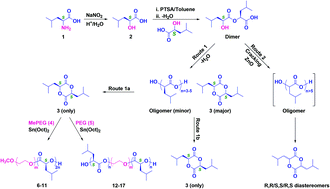Symmetrical substituted glycolides: methodology and polymerization†
Abstract
Poly(substituted glycolide)s have emerged during the past decades to create extraordinary breakthroughs in a wide range of therapeutic applications due to superior properties as an alternative to PLA and PLGA systems. Herein, we report highly controlled synthesis of symmetrical diisobutyl glycolide to reveal the mechanistic pathway of non-functional symmetrical glycolides and to achieve highest yields in a short period of time without notable racemization for maximizing its potential for clinic use. Optically active PEG-based symmetrical glycolide copolymers showed linear correlation of molecular weights with monomer/catalyst ratio, linear increase of molecular weights as a function of time, a great match between the theoretical (Mn;theor) and experimental (Mn;GPC, Mn;NMR) molecular weights, monomodal GPC traces, high conversions (up to 99.2%), low polydispersities as low as 1.11, good specific optical rotations (up to −106.2°), and short reaction durations (only 3 h). Also, it was found that the reactivity of polymerization of symmetrical glycolides strongly depends on nature of substituent (i.e., isopropyl vs. isobutyl) on glycolides. The increase of hydrophobic component in diblock copolymer resulted in a rise in Tg (from −2.1 °C to 16.4 °C) and a decrease in Tm of PEG block component (from 45.5 to 41.8 °C, and finally disappeared) according to thermal analyses. Formulated nanoparticles were spherical in shape with average sizes as low as 180 nm and very good polydispersities as low as 0.032, and they showed drug loading percentages up to 7.22%. PEG component also facilitated the degradation of copolymers (i.e., 46.7% reduction in molecular weight at the end of a month at 37 °C).



 Please wait while we load your content...
Please wait while we load your content...